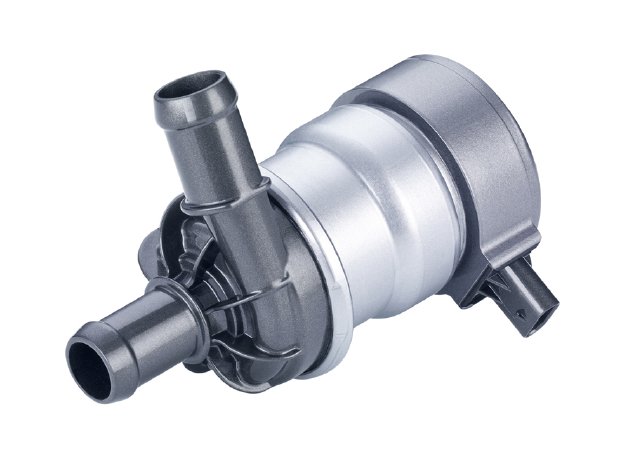With three main types, Pierburg meets customer requirements in the small, medium and higher power ranges of electric coolant pumps. The smallest "family member" at the lower end of the power spectrum is the water circulation pump (WUP), which develops 15 to 20 watts, has a 1-phase EC motor and is equipped with a Hall sensor for commutation. The fields of application of this pump are manifold. For example, the pump is used for thermal management of transmissions, indirect charge-air cooling of smaller combustion engines, post-operational cooling of turbochargers after the combustion engine has been switched off, and cooling of exhaust gas recirculation to reduce nitrogen oxide emissions.
Pierburg has developed a three-phase sensorless commutated WUP for use in electric vehicles in which the noise emission of the pumps has been kept at a very low level. The WUP has been in series production since 2018. It covers a power range of up to 50 watts. The sound level is less than 25 decibels, and hence the pump is not audibly perceived even when the vehicle is stationary. It is used, for example, for air conditioning in the passenger compartment or for cooling electric motors, batteries or power electronics.
CWP pumps for the medium power range
Their big "sisters" CWP 35, 50, 65, 150 and 250 deliver 35 to 250 watts. They have a sensorless 3-phase EC engine and are mainly used for cooling auxiliary units, for example also for indirect charge-air cooling of turbo engines. Another area of application is the cooling of drive motors, power electronics and batteries of electrically powered vehicles and hybrid cars.
CWA offers ultimate performance
For the higher performance range, the supplier has the CWA 400 and CWA 950 pumps in its product portfolio. Both also have a sensorless 3-phase EC motor and are rated between 400 and 950 watts. While the CWA 450 is powered from the 12-volt vehicle electrical system, the CWA 950 is designed for a 48-volt vehicle electrical system. Nowadays, these pumps are used for the main cooling of the combustion engine and for cooling the fuel stacks of fuel cell drivelines.
Indispensable in modern engine models
The areas of application for electric coolant pumps are very diverse. They are used in vehicles with combustion engines, hybrid and electric vehicles, and models with fuel cell driveline. Their main task is always to enable optimum thermal management for a combustion engine, an electric motor or other components such as batteries or power electronics. The advantage of electric pumps over mechanical counterparts, i.e. belt-driven pumps, is that they allow on-demand cooling for any situation, regardless of the engine speed, even after the engine has been switched off. In the case of battery-only vehicles, they are also the sole option for cooling components with a water circuit.
Background information: Development phases of electric coolant pumps
An electrically driven coolant pump consists of three subsystems: hydraulics, motor and electronic control. With every new development, attention is paid to the integration of these modules in order to further reduce the footprint, weight and number of components. Pierburg has more than two decades of experience in the development and production of electric coolant pumps and has long achieved its initial development goals, such as the durability of the electronics in extreme ambient temperatures and vibration profiles. Advanced communication and diagnostic functions have also been systematically further developed, so that customers today benefit from comprehensive diagnostic information about the pump. Also important is the low noise emission of this type of pump, which has been achieved by engine optimization during commutation and pressure pulsation reduction and the right hydraulic design to ensure that electric pumps are barely audible even when the engine is switched off.


